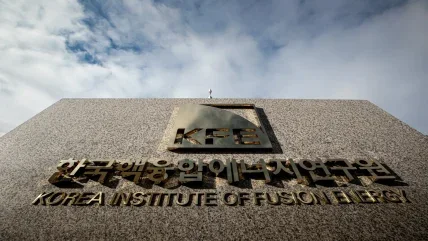
South Korea has begun preparations to begin building a nuclear fusion reactor after 2035. It aims to produce electric power around 2050 in a bid to keep up with the intensifying international competition for the future clean and limitless energy, the Ministry of Science, Information & Communication Technology said.
According to the government’s long-term outline, approved by the national fusion commission, South Korea’s first fusion reactor will have a capacity of 500 MWe, with a major radius of 7 metres, according to the Ministry. The government will lead R&D to secure basic technologies and innovation for the project until 2035 – the date when the International Thermonuclear Experimental Reactor (ITER) is expected to begin operation. South Korea joined the ITER consortium in late 2006, which is also includes the European Union, the USA, Russia, China, Japan and India.
“If ITER succeeds in substantiating the feasibility of fusion power generation around 2035-38, a fusion power plant will be likely available around 2050,” Yoo Suk-jae, President of the Korea Institute of Fusion Energy (KFE), told a press conference. He cited the 14-year gap between the discovery of the nuclear chain reaction in 1942 and the operation of the first fission reactors.
“After the success in 2035, we will have to be ready to change our mode to designing and building at once,” he said. “The outline is about our action plan to be fully aware of all the necessary technologies and processes.”
While carrying out basic scientific and engineering research, the government will form a task force to draw up the broad outlines of function and form of a new fusion reactor later this year in order to complete a final design by 2035. If the reactor is constructed as planned, it will begin operations around 2050, the Ministry added.
South Korea has been a leading player in the global fusion sector through operation of its tokamak fusion reactor, the Korean Superconducting Tokamak Advanced Research (KSTAR). It was built in 2007 and has a radius of 0.5 to 1.8 metres. KSTAR features fully superconducting magnets to study technologies for operating ITER-led fusion reactors, and has achieved several world records by confining and maintaining hydrogen plasma at higher temperatures and for a longer time than any other reactors in the world.
KSTAR maintained a plasma at 50m degrees C for 70 seconds in 2016 for the first time in the world and achieved 100m degrees C for 30 seconds in 2021. KFE is now upgrading KSTAR aiming to confine plasma for more than 50 seconds at 100m degrees C. Its ultimate goal is to reach reaching 300 seconds by 2026.
“We can now see we are much closer to commercial fusion power,” said Yoo. “Fusion power is expected to play a role in solving our energy-related problems such as climate change, national security and technology dominance.”
“The competition to commercialise a fusion reactor around 2050 is intensifying,” Deputy Science Minister Oh Tae-seog said. “We will do our best to secure core technologies for a fusion reactor on our own and seek international cooperation as well.”
Image: General view over the tokamak-type nuclear fusion reactor, called the ‘Korea Superconducting Tokamak Advanced Research’ (KSTAR), at the National Fusion Research Institute in the central city of Daejeon, South Korea (courtesy of EPA-EFE/YONHAP)






